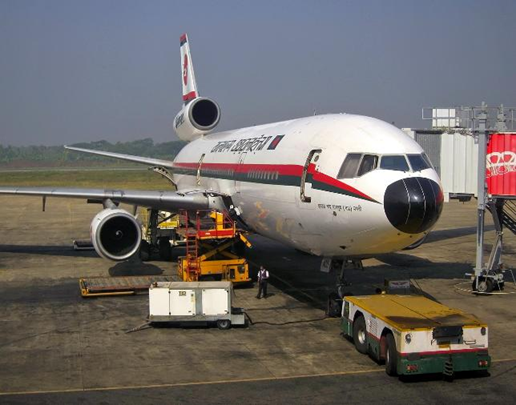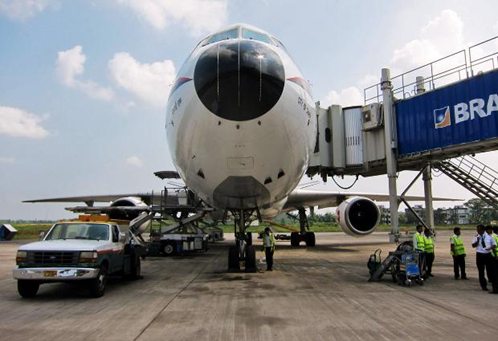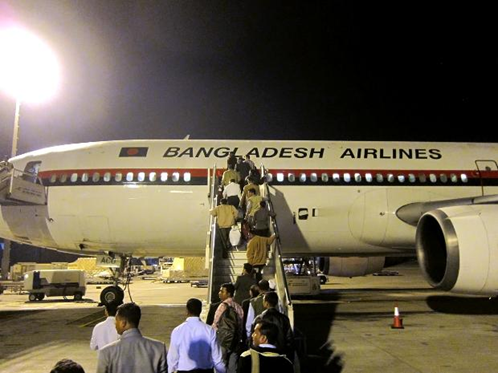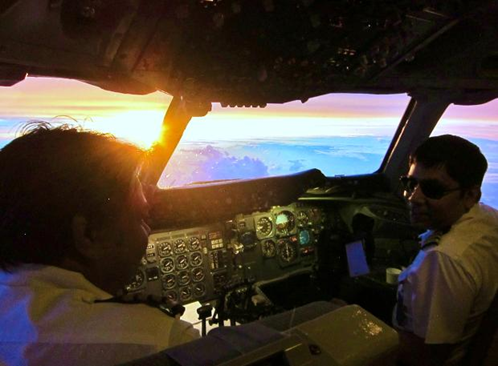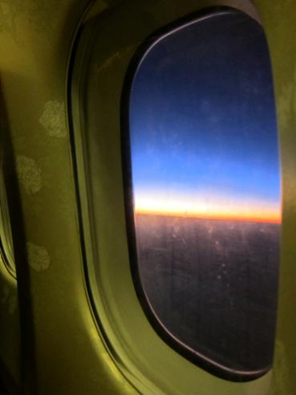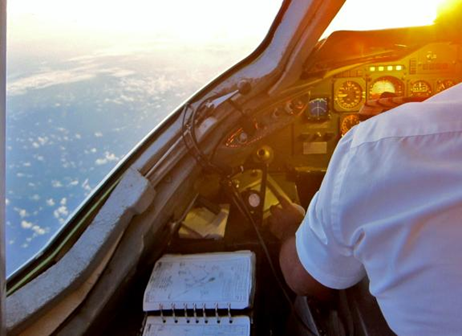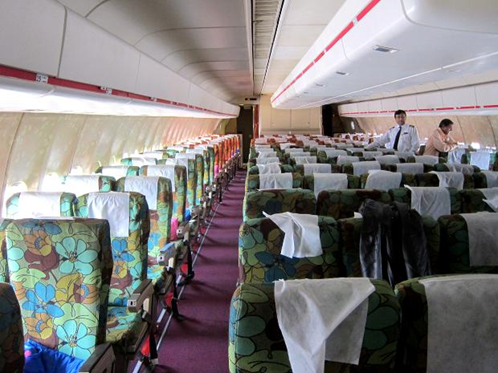BIMAN BANGLADESH DC-10
Home-bound to Chittagong
by Charles Kennedy
|
The titans of the early jet age are almost gone from the sky. We now fly in a brave new world of electric jets, with interiors squeezed out of a toothpaste tube, two-man cockpits of digital screens, unprecedented fuel efficiency and an accident rate that is close to zero. The Airbus A340 and Boeing 777 have now flown for a couple of decades without a single fatality.
While this has happily resulted in more reliable and affordable air transport than at any time in history, the by-gone age of trijets, spiral staircases and colourful interiors is much missed by connoisseurs of air travel, so as the old types are retired, one must cherish the remaining few before they join their contemporaries in the desert boneyards. One such survivor is the McDonnell Douglas DC-10, now serving just one passenger airline: Biman Bangladesh. Air travel began in what is now known as Bangladesh sometime before the second century BC, when the Ramayana, a Hindu scripture, referred to, “A Pushpaka chariot that resembles the Sun...going everywhere at will; that excellent chariot resembling a bright cloud in the sky. And the King Rama got in, and the excellent chariot, at the command of the Raghira, rose up into the higher atmosphere.” Nineteenth century Hindu scholar Swami Dayananda Saraswati looked back at an ancient technology that involved, “Jumping into space speedily with a craft using fire and water... containing twelve pillars, one wheel, three machines, 300 pivots, and 60 instruments.” These gigantic flying machines were called Vimana, which in modern Hindi became “Biman”, the word for “aeroplane”, and contemporary Bangladesh adopted the name for its flag carrier founded in 1972, the year after the birth of the nation. 158 million souls make Bangladesh the seventh most populous nation in the world, despite being only number 95 for land area, a third of which floods every year due to it’s low elevation and heavy monsoon season. Hence, many of it’s citizens seek employment abroad, both in Europe (especially the United Kingdom, where they are the sixth biggest foreign-born community) and more recently in the Persian Gulf, where they make up a large percentage of the workers who have transformed cities such as Dubai, Doha and Abu Dhabi from backwater trading ports to gleaming futuristic metropolises. Biman started out with a fleet of Boeing 707s mostly acquired from Northwest Orient Airlines, flying regionally to the likes of Rangoon, Bangkok and Singapore, and later across India, the Persian Gulf and on to the already-growing Bengali community in London. The widebody era dawned relatively late in the skies over Bangladesh with a judiciously-sourced trio of four year-old DC-10s from Singapore Airlines, delivered to Dhaka in August 1983. A fourth was delivered new from Long Beach in December 1988 (the second-last DC-10 built). Two further aircraft were bought from Canadian Airlines in 1999 and 2000, one of which was written off in a non-fatal landing accident at Chittagong in July Today, one ex-Canadian machine (S2-ACS) and one ex-Singapore machine (S2-ACQ) are parked at Dhaka airport, used as Christmas trees by the maintenance department for spare parts to keep three others flying – the two remaining Singapore Airlines machines (S2-ACO and ’P) and the late-build S2-SCR. The airline also flies two Boeing 737-800s, three Airbus A310s, and four vintage Fokker F-28 Fellowships. The DC-10s have been replaced on the airline’s most prestigious routes to Europe by four brand-new Boeing 777-300ERs, but remain in service on routes to the Persian Gulf for their low-cost people-moving ability, and to Hong Kong for their cavernous cargo space. We pick up the story of flying on a vintage widebody with a group of four airline historians in early 2012 aboard a shuttle bus to the southeast end of Abu Dhabi airport and its “low cost” Terminal 2. This terminal serves Pakistan with Air Blue (ED), Nas Air (XY), Shaheen Airlines (NL), and flag carrier Pakistan International Airlines (PK); Iran with Iran Aseman (EP) and Kish Air (Y9) and an assortment of exotic flag carriers including Sudan Airways (SD), Turkmenistan Airways (T5) and Yemenia (IY). But today we are more interested in its five times weekly service to Dhaka, via Chittagong or Sylhet, aboard Biman Bangladesh. Check-in for BG 028 opened at midnight for an 0200 departure, but keen passengers began arriving at the terminal in the middle of the evening, forming a long orderly line outside the building. While some were traders and businessmen, most had come to the Persian Gulf to work on construction sites, building roads, bridges, ports, and the sci-fi skyline of this once sleepy port. All have been away from their families and homes for months, and many for years. Check-in was handled by Etihad Ground Services, whose agent was happy to ensure I got a window seat behind door 2, next to the right engine, to enjoy the sunrise that would greet us as we crossed the Arabian Sea. Security and emigration was quick and professional, and led into the departure lounge. A large room with seating, duty free shop and small snack bar faced the all-glass end wall with two bussing gates that looked out onto the general aviation apron, affording an excellent view of the aircraft parked directly outside. Biman have a reputation for a rather loose interpretation of schedule, but our aircraft arrived almost on time at 0030, and it’s load of 314 arrivals were quickly deplaned and turnaround began. I spotted the pilots for our flight in the duty free and introduced myself. By lucky chance, I had been in a DC-10 simulator filming for a documentary the previous week, and was able to show them photos from the session, as credentials. Do Biman ever allow jumpseat rides? The Bangladeshi pilots looked at each other and smiled enigmatically. I left them to finish their shopping and re-joined my group. Boarding was announced and the entire room stood up and formed a line. Buses were used to ferry passengers the few metres to the foot of the steps of the mammoth DC-10 that towered over us, humming with ground power and surrounded by technical crew, security, caterers, refuellers. Sure enough, as the aircraft trundled slowly northeast on taxiway Zulu, the purser reappeared and gestured to me and one of my travelling companions. Not needing to be invited twice, we leaped from our seats, through the curtain and forward galley, and into the comforting darkness of the wide and spacious cockpit, its distant surfaces presenting a galaxy of glowing dials and buttons. The only digital equipment were the TCAS-equipped vertical speed indicators (VSI) on each pilot’s panel. The flight engineer gestured to the two jumpseats, one low down in the centre of the cockpit between the two pilots, and one high up on the left side behind the captain. My colleague and I buckled into the five-point harnesses and prepared for launch. Final checklist: elevator trim set; spoilers retracted; takeoff data set; flaps set; landing lights on; strobe on; pitot heat on; ignition continuous. The captain pushed the throttles up, then briefly released them so the flight engineer – ‘the best autothrottle ever installed in an aeroplane’ – could finesse the levers into position, lining up the needles on the gauges of the centre panel. Takeoff power was set and we were rolling. Eighty knots and the captain released the nosewheel steering wheel by his left knee and steered us down the centreline using the flight controls. At V1, committed to takeoff, he let go of the throttles for good. Finally – rotate, and the nose lifted into the air. A second later, the rumble of the main gear on the tarmac ceased and we were airborne, climbing steeply and confidently into the dark night air. Gear up, and the four greens turned red on the panel as the wheels retracted into their bays in the belly of the beast. A moment of drama followed when the tower controller alerted us: no radar contact, recycle your transponder. His screen must have been showing just a primary radar return, without the flight number, type, speed and altitude. The first officer reached to the comms panel behind the throttles and threw the selector past standby to off, then back. It worked. The tower controller announced radar contact established, then handed us over to Abu Dhabi Departures. As we climbed on a heading of precisely oh-nine-oh towards the lights of Oman, the horizon ahead began to emerge out of the inky blackness, first azure, and then the reds, oranges and yellows of a Persian Gulf sunrise. We all watched in awe as we cruised at Mach 0.82 towards the start of another day. Once established in the cruise, I returned to the passenger cabin to enjoy Biman’s meal service. Although by now it was early morning, the 0200 scheduled departure put the flight into a catering no-man’s-land, so the tasty curry (chicken or lamb) with a bread roll, a small dessert, tea, coffee, water, or cola was perfectly appropriate to the hour. The flight continued over India with broad daylight streaming through the 787-sized windows, with passengers chatting in groups, sleeping, reading. The front of the aircraft was soundtracked by the hiss of the slipstream, accompanied by the distant thunder of the engines as one walked aft, with the number two engine invisible above the heads of the cabin crew selling the last of the duty-free in the cavernous rear galley. Playing cards, alarm clocks and good quality Wooster-style snap-together models of Biman DC-10s and Airbus A310s were available; I bought the lot and asked for spare logo’d carrier bags to go with them. I put the alarm clock into use the very next morning, and despite the flight attendant’s warnings regarding its age and possible reliability issues it keeps perfect time. After four hours, the roar of the engines died away and we became a huge metal glider, sinking towards Earth. Two members of our group were invited back to the cockpit for landing while I enjoyed the side view from the huge windows in the forward passenger cabin. We made landfall over the beach at Faujdarhat, famous as the graveyard for many of the world’s biggest ships. From my vantage point I could see hundreds of old liners, supertankers, ferries and hulks in various states of disrepair and deconstruction, some already half submerged, some capsized, all doomed. Perhaps the captain of the Costa Concordia has dreams like this. Seatbelt signs, cabin checks, announcements in Bengali. Thumps and whirring sounds as the slats and flaps were extended; gear down. Bangladesh was lush and green, but obviously flood-prone; the clear reflection of the sun tracking across wet fields and countryside. Over the airfield fence, then tarmac, and finally we settled with an extended rattle onto runway 05 at Chittagong Shah Amanat International Airport. With a long roar of reverse thrust we slowed, rolled out to the end, turned in the hammerhead and backtracked to the midfield turnoff, then set the brakes in front of the recently refurbished terminal. The anticipation in the crowded area around door 2L was palpable. Finally the door lifted open by its loud electric motor and the full complement of proud Bangladeshis surged into the jetbridge. Welcome home. During the ground stop, the pilots invited our small group of enthusiasts out onto the tarmac to join them for the walkaround, during which we could take pictures and inspect the aircraft close up, a unique opportunity for any vintage jet enthusiast. Also on the ramp were a few colourful aircraft from Bangladesh’s independent airlines – a McDonnell Douglas MD-80 of GMG Airlines and a Dash 8 of United Airways (who might be changing their name, unsurprisingly). Due to the cheap price of jet fuel in the Persian Gulf, we had departed Abu Dhabi with full tanks, so topping up in Chittagong was unnecessary. 171 passengers left us, and 171 domestic travellers joined. Less than an hour after blocking in, we were ready to push back and start up for the short sector to the capital city. This second and final leg was so short the cabin crew did the drinks service – handing out 314 juice boxes of a local orange confection – during the taxi instead of the flight. Despite the full load of passengers and bags, our DC-10 roared purposefully into the cool air of the Bengali morning and up to 16,000 feet for the final 142 miles of the journey. The two DC-10 aficionados who had won the coin toss to enjoy this takeoff in the cockpit jumpseats soon left the front office and I returned to my perch behind the captain’s seat for the final descent and landing. As I strapped in, the three pilots worked their way through the arrival procedure – checking the local weather, resetting the altimeters to the local barometric pressure, setting elevator trim to match our weight and balance, navigating the Dhaka airspace, slowing the aircraft down, and configuring for landing. Slats out first, then flaps 15-22-35, gear down. The city sprawled beneath us in hazy sunlight as the final checklist was called. Seat belt signs on, landing lights on, spoilers armed, flaps thirty-five-thirty-five-green-light. Autopilot off and the big jet was in the hands of one man, final corrections to the centreline made with some forceful jabs, TWO HUNDRED called the recorded voice of the radio altimeter as we skimmed over fields, a dirt road, two boys, a bicycle; ONE HUNDRED - then the threshold marked with the faded numbers 1-4 sliding beneath us. Power off, and twenty-three minutes after liftoff from Chittagong, we settled gracefully onto the Dhaka tarmac. The spoilers deployed and the captain reached forward to grasp the reverse-thrust levers, creating a muted roar and deceleration. The co-pilot called eighty knots and the reverse thrust was dispensed with; as we decelerated further, ground steering was used to taxi to the far end of the runway, before turning left onto the taxiway that would lead us to the terminals at the heart of Biman’s route network, pulsing its lifeblood of six million passengers a year to sixteen countries. Welcome to Shah Jalal International Airport. We parked among the typical widebodies spaced around the seven jetbridges: a Saudia 747; 777s from Thai and Qatar. With a heartfelt farewell to the cabin crew and pilots who had made our journey so memorable and worthwhile, we bundled into the attractive and architecturally distinctive terminal to find a well-staffed transit desk where we were able to quickly print boarding cards for our onward Biman 737 to Kathmandu and be on our way. How long will Biman’s ancient Vimana continue to fly? Everyone in the airline has a different answer – weeks, months, years. I recommend you waste no time in booking your own ticket to an undiscovered country, with an airline that will capture your heart, aboard an aircraft that – for better and for worse – defined a bygone era. HISTORY OF THE DC-10 The Douglas Aircraft Company, founded in Santa Monica and latterly of Long Beach, California, defined early air travel with its succession of DC propliners. 16,079 DC-3s were built between 1936 and 1942, including nearly 5,000 in Russia and another 500 in Japan. The four-engined DC-4, DC-6 and DC-7 followed, continuing Douglas’ untouchable reign over civilian air transport, but with the most to lose, they were hesitant entering the jet age. Their DC-8 was a success, but the race was lost to Boeing’s 707 and while the DC-9, a nimble twin-jet which brought jet service to smaller communities was a huge sales success, corporate mismanagement, and in particular the offering of endless customer options (including twenty-seven shades of white paint) resulted in continued losses and the acceptance of a merger bid from military supplier McDonnell Aircraft in April 1967. It was make-or-break in the civilian field. American and United were looking for a domestic widebody with seating for 300 that could land at New York’s postage-stamp La Guardia, had the range to fly from Chicago to Los Angeles and the ability to clear the Rocky Mountains with an engine out, thus precluding a twin jet. Lockheed had already started work on what would become the L-1011 Tristar. McDonnell Douglas knew if they lost this race, they would be out of the civilian aircraft business forever. The motto at the plant in Long Beach became “Fly before they roll” – fly the first DC-10 before the first Tristar even rolls out of the Lockheed factory. By simplifying the design, the first prototype DC-10 soared into the deep blue sky over the Pacific on August 29, 1970, almost three months before the Tristar. Orders came flooding in, 25 to American Airlines and 30 to United, followed by US trunk carriers National, Northwest Orient, Continental and Western. International sales followed, favouring the long range series 30, including Lufthansa and the KSSU consortium in Europe (KLM, SAS, Swissair, UTA), Japan Air Lines, Air New Zealand and PIA. The choice of powerplant helped. The General Electric CF6 had none of the development problems that plagued the Tristar's Rolls-Royce RB.211s. But elsewhere compromises had to be made, some visible – DC-10’s centre engine ran straight through the base of the vertical tail, while the Tristar’s centre engine was gracefully buried inside the rear fuselage. Eschewing the highly complex systems of the Tristar was both a blessing and a curse, the latter of which made the phrase “DC-10” a useful shorthand for fear of flying in the 70s. The first crash befell a Turkish Airlines DC-10, fully loaded with 346 passengers and crew, en route from Paris Orly to London Heathrow, on the afternoon of March 3, 1974. At 13,000 feet a cargo door opened, causing an explosive decompression that collapsed the cabin floor and jammed the control cables, sending the aircraft into an uncontrollable dive. There was no way of removing all the tiny pieces of wreckage from the crash site in Ermenonville forest; to this day, hikers respectfully place pieces on the nearby memorial. It turned out the door design was already an issue, and had nearly downed an American Airlines DC-10 the previous year. Then on May 25, 1979, an American Airlines flight shed its left engine after take-off from Chicago O’Hare airport, damaging hydraulics in the process and causing the leading-edge slats on the left wing to retract, stalling the left wing and rolling the jetliner upside down before crashing into a caravan park, killing all 271 on-board and two on the ground. The outcry over the crash meant Congress had to take action, and revoked the type’s airworthiness certificate for two weeks, grounding all US-registered machines and banning foreign carriers from landing their fleets in the US. Two more crashes later in 1979 unrelated to the aircraft’s design forever associated it in the public mind with flawed technology and the “DC” gave rise to it’s nickname – the “Death Cruiser”. While the design faults were real, and the bad reputation they engendered somewhat justified, there was a lot to like about the DC-10. Airlines certainly thought so, buying 446 by the time production ended in 1989, in contrast to only 250 Tristars. This can be partly credited to entering service nine months ahead of the competition, but maintenance loved the dispatch-friendly simplicity of the aircraft systems and design; pilots loved the unfussy and reliable automation and hydraulically-powered flight controls that moved gigantic, highly responsive control surfaces with effortless input; and cabin crew loved the huge galleys and twin-aisle configuration to work in. Most all, airline accountants loved the low-cost operation of this people mover. However by the turn of the century, a new generation of widebodies – the Boeing 777 and Airbus A330 / A340 – were able to do the same job with less fuel and a two-man crew. Only FedEx remained committed to the type, reengineering 92 airframes with digital two-man cockpits and recertifying them as “MD-10s”. |
|
